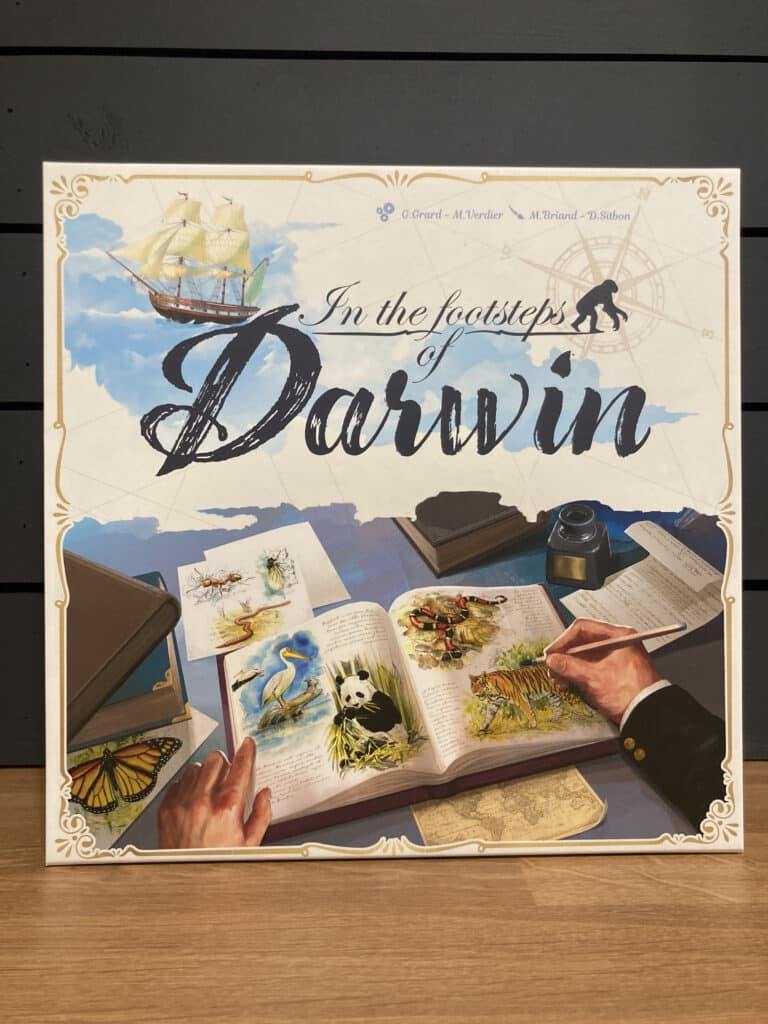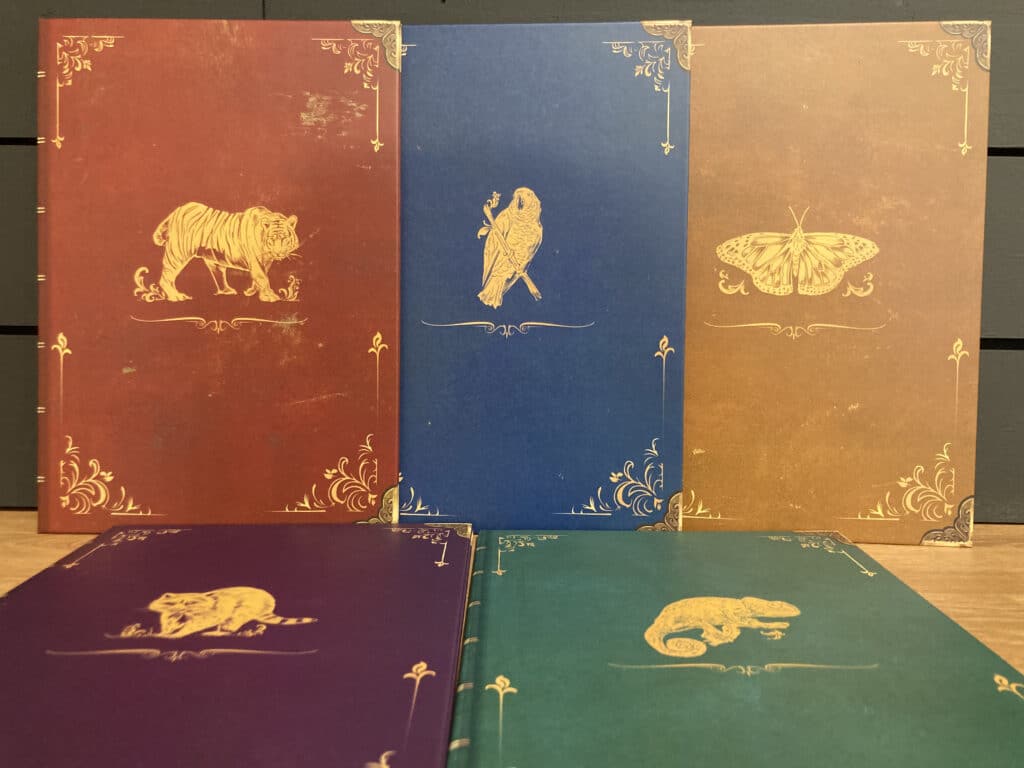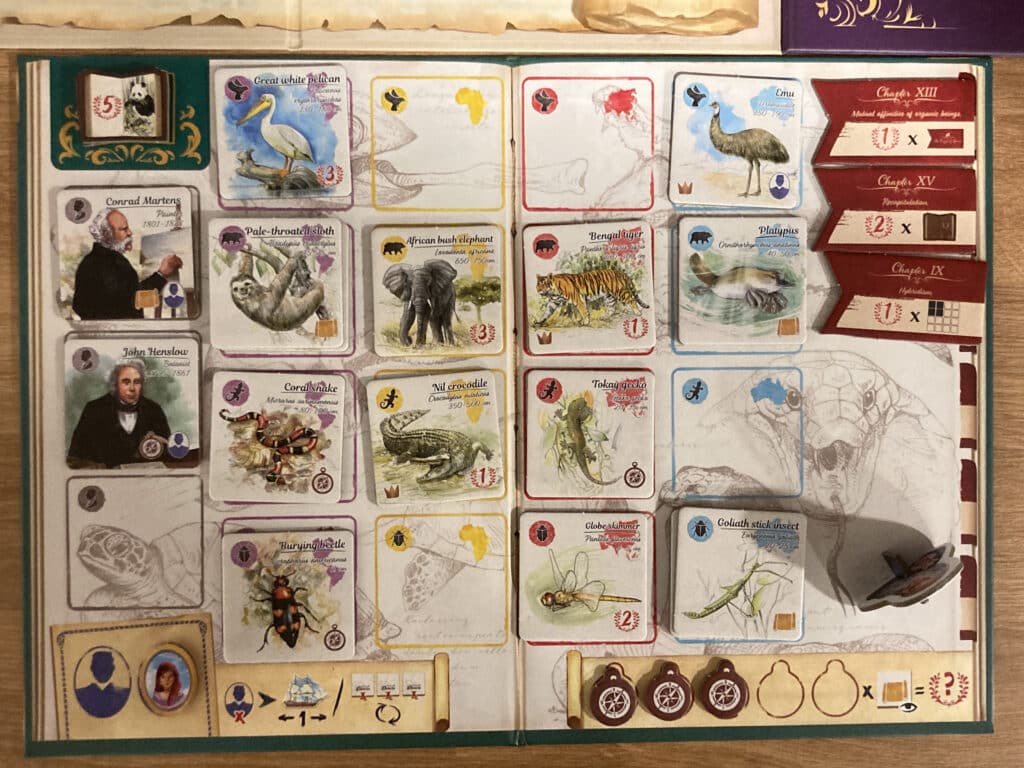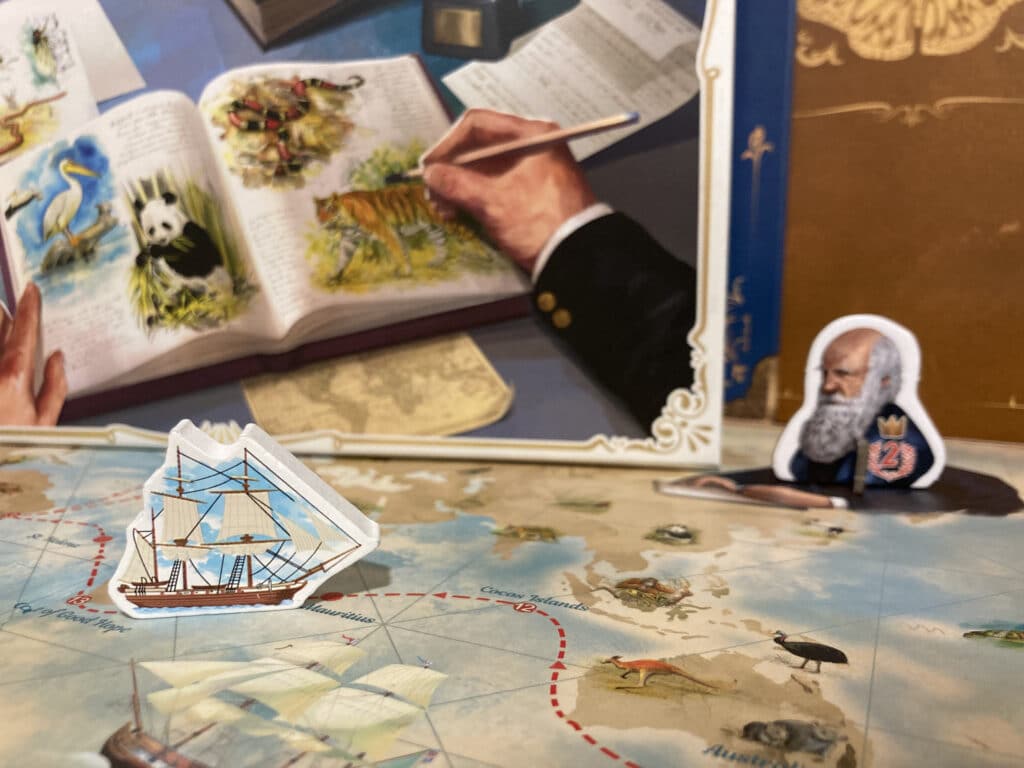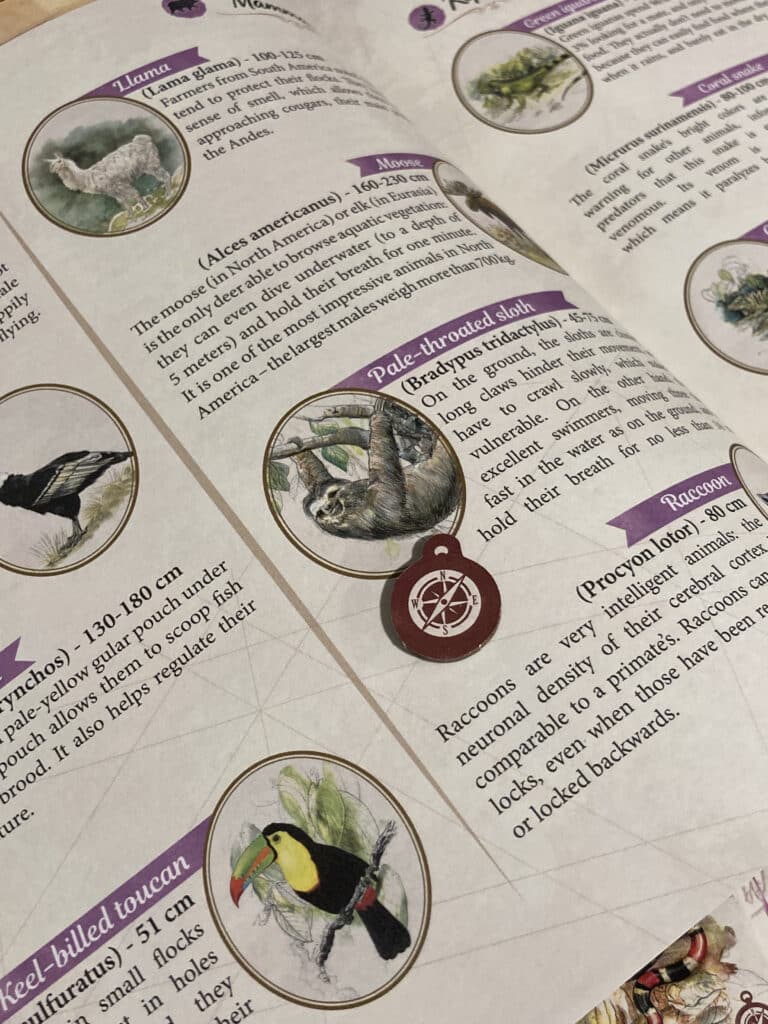Sometimes a board game comes along that is not only fun, but it also serves an educational purpose. In the Footsteps of Darwin, published by Sorry We Are French, fits that description exactly,
Designed by Grégory Grard and Matthieu Verdier, In the Footsteps of Darwin thrusts players into the roles of naturalists following Charles Darwin aboard the Beagle – a ship, not a dog – to study species, develop theories, and write publications.
All of this is wrapped up in a pleasant package that you can use to learn some history and animal facts along the way!
So grab your binoculars and prepare those pens because it’s time to walk In the Footsteps of Darwin!
In the Footsteps of Darwin Gameplay
In the Footsteps of Darwin is a tile-collecting game where the tiles you collect must be placed in specific positions on your individual player board. The good news is that you can always place a tile that you pick up; if you happen to grab one that needs to be put in an occupied space, you just place it on top of the existing tile.
The H.M.S. Beagle token dictates which tiles can be taken from the 3×3 grid. Players may take any of the three tiles that the ship is facing, adding that tile to their tableau. Then, the ship moves clockwise around the tiles according to the position of the tile that was chosen. For example, if the tile chosen was right next to the Beagle, then the Beagle only moves one space. However, if the tile chosen was the furthest, the ship moves three spaces.
The object of the game is to have the most points, which are awarded in a variety of ways:
- Theories – Theories are individual scoring objectives that might be something like earning a point for every North American animal that you have, or 2 points for each of your Publications
- Publications – When you complete a row or column, you earn 5 points in the form of a Publication
- Animals (Discoveries) – Some animals are worth points, as indicated on their tile
- Chart – Some animals have a chart icon. You earn points for that icon equal to the number of Compass tokens that you collected over the course of the game
- Darwin Token – Controlling the Darwin token at the end of the game grants you 2 points
Of course, you also have the opportunity to use your Guide tokens to influence the Beagle. You can use them to go forward or backward one space, or you can use it to refresh the current row/column of tiles that the Beagle is facing.
Whoever has the most points at the end of the game is the winner!
Staking Our C.L.A.I.M. on In the Footsteps of Darwin!
![HMS Beagle Icon]() Components
Components
The production quality of this game is excellent, especially since there are several components that technically aren’t needed for gameplay but instead serve an educational element. In the Footsteps of Darwin primarily plays with standard cardboard tiles, around which sails a screen-printed H.M.S. Beagle token. All of the other tokens – the compasses, publications, guides, etc – are all the same thickness and quality and will easily hold up to all of the constant handling that takes place during the game.
What I’m most impressed with are the player boards. Each board is themed around a different animal and features stunning art which I’ll talk about more in the Aesthetics section of this board game review. In terms of quality, however, these cardboard players boards fold out where they easily could have been a much thinner, flimsier material.
Combine that with the extra Appendix that is comprised of several pages of animal and historical facts, and you can see the care and attention that went into the production of In the Footsteps of Darwin. None of these components are free additions and yet they were included to fit the vision and intention of the designers and publisher. It says a lot in an industry where component costs add up quickly.
![HMS Beagle Icon]() Luck
Luck
Although the gameplay is relatively simple, I still found there to be plenty of opportunity for strategy while playing In the Footsteps of Darwin. For the most part, you’re just going to be focused on the three tiles that the Beagle is pointing at. However, the real strategy comes in through the use of the Guides and by using your tile selections to impact the future choices of other players.
Let’s talk about Guides first. The flexibility of Guides make them incredibly enticing, although you’re usually sacrificing points in the moment for potentially more points in the future. You can use them for yourself, to get a tile that you really need to complete a row/column, which is probably the most common usage.
However, since a Guide can refresh a row/column from the ‘market’, you can use them offensively to deny animals that your opponents might want. Having that flexibility, and knowing when to use your Guides is a great example of how strategic depth is created with In the Footsteps of Darwin.
Of course, your tile selection impacts what tiles are available to your opponents as well. When selecting between 2 tiles that might be equal in your eyes, you can choose the one that offers a worse choice for the next players. This can even force them to use a Guide token if they really want to take a tile that they otherwise would have had to pass up.
![HMS Beagle Icon]() Aesthetics
Aesthetics
In the Footsteps of Darwin is incredibly beautiful in its presentation. My hat goes off to Maud Briand and David Sitbon who did an amazing job at evoking the feeling of realistic animal sketches that you might find in a naturalist’s journal or a scientific publication. Especially one that you might find in the 1800s when Darwin was doing his research.
I also love the player boards, as I mentioned above. They tie in so perfectly with everything else and makes each one feel unique. Although I must say…I don’t want to play as gold/yellow because of the tarantula staring back at me.
Everything else in the rulebook makes me feel like I’m reading a textbook, but an interesting textbook that has plenty of images and gives me the necessary information without being boring or dry.
From a mechanics perspective, I really appreciate all of the subtle rules and clarification reminders that are on the board. During my second game, it had been a few days since the first play and I couldn’t remember how to get more Theory tokens. BOOM – it’s right there on the board with iconography. Those are the kinds of things that mean I don’t have to reference the rulebook because they just spark the old memory banks, and I love that.
![HMS Beagle Icon]() Interest
Interest
Well, naturally I have to say that anybody who is already interested in the studies of Darwin, naturalists, history, or animals will find In the Footsteps of Darwin to be something they want to take a look at, just based on theme alone. It’s also a very quick game; the box says 30 minutes although if you’re playing with one other person and you both have a game or two already under your belt you can definitely be done more quickly than that. Multiple consecutive playthroughs can certainly be on the menu for game night.
I’m also reminded a lot about Targi, perhaps my favorite two-player board game. There’s a similar mechanic in play where there’s a two-dimensional market in front of you but your choices are dictated by token/pawn placement. Couple that with some set-building and you have another similar game with In the Footsteps of Darwin. So, if Targi is a game that you like, check this one out!
![HMS Beagle Icon]() Mood
Mood
The market may seem large with 9 possibilities, but I assure you that there’s tension in your choices by only having a third of those available to you. There is a good chance that a tile you see on your turn won’t even be on the board the next time it’s your turn to choose, which means that there’s a lot more weight on each of your choices.
All of the player interaction comes through the market; players will take tiles you want, you’ll do the same for them, and the Beagle won’t always line up well with what you were planning. This gives you all of the opportunity to revise your strategy as the game goes on. Maybe you weren’t planning on accumulating a bunch of charts and compasses, but if that’s what the game is giving you then you need to capitalize on the opportunity.
Overall, the In the Footsteps of Darwin board game is quite relaxing, almost as if you’re on a long journey in the 19th century, albeit with all of the modern amenities of the present. And there’s no getting seasick, unless you play this game on a boat in which case please don’t quote me.
In the Footsteps of Darwin: That’s a Good Beagle!
I ended up being pleasantly surprised by In the Footsteps of Darwin, not only due to its production quality but also by the snappiness of the gameplay and education value. It’s just a very solid game that you can teach incredibly quickly, and the rules overhead is minimal.
My board game tastes have continually evolved and it’s only fitting that I award In the Footsteps of Darwin with the coveted Nerds on Earth Seal of Awesomness Award! I’m going to love teaching this one at Gen Con because it doesn’t take long for the game to ‘click’ and just…work.
You can pick up a copy of In the Footsteps of Darwin from your FLGS when it releases on June 7th, or you can preorder from Hachette Boardgames directly.
[Disclaimer: Nerds on Earth was provided a copy of In the Footsteps of Darwin from Hachette Boardgames in exchange for an honest review.]


